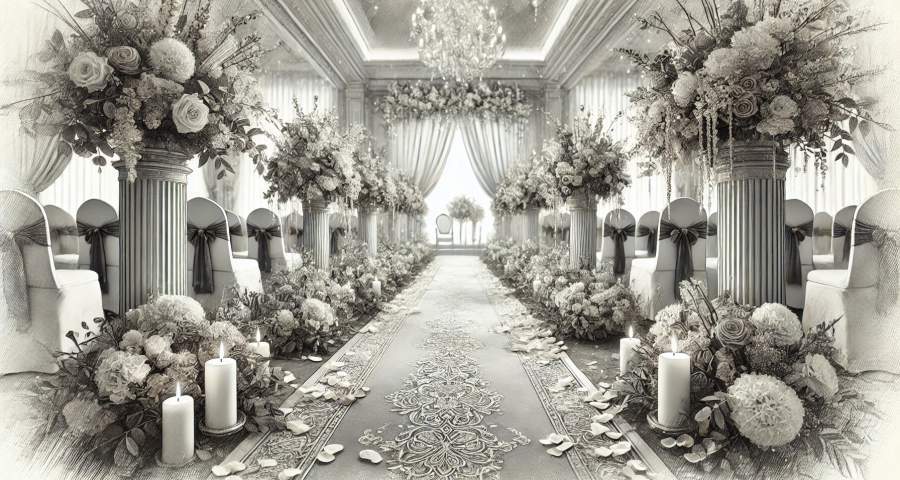Your wedding ceremony is one of the most meaningful and memorable moments of your life.
The decorative touches you add will set the tone and ambiance for this sacred celebration of commitment.
Decorating the wedding ceremony venue helps to transform the space, making it feel more personal and unique.
Whether you’re exchanging vows in a church, on a beach, in a garden, or in a grand ballroom, the decor you choose can enhance the venue’s natural beauty or even redefine its appearance.
The decorations at your ceremony are a direct reflection of your personality and style as a couple. This could be expressed through colour schemes, floral arrangements, or unique elements like vintage furniture or a customised backdrop for photos.
While aesthetics are crucial, it’s also important to consider the practicality of your decorative choices, ensuring they complement the ceremony proceedings.
Understanding Your Venue
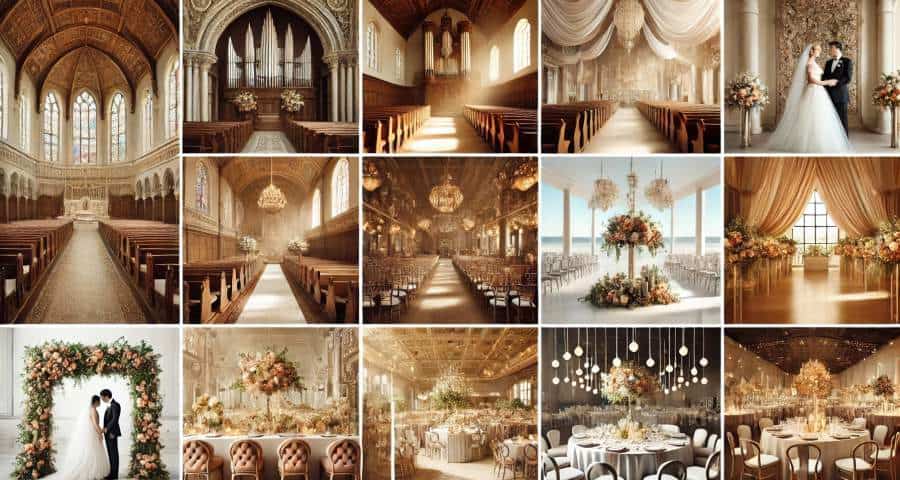
Choosing the right decorations for your wedding venue is about more than aesthetics, it requires a deep understanding of the venue’s inherent features and any restrictions on decorations. These venues often come with fixed architectural elements and specific rules that must be respected.
- Work With the Venue’s Characteristics: Each type of venue presents unique opportunities and challenges. Here’s how to tailor your approach:
- Churches: Typically feature fixed pews and strict guidelines. Opt for freestanding decorations like fabric bows or pew end flowers to enhance the solemn atmosphere without violating rules.
- Historic Halls: Often boast vintage woodwork or delicate artefacts. Choose non-invasive decorations that complement the ambiance and protect the heritage.
- Modern Spaces: Usually more flexible, allowing for a variety of decorations. Consider elements like metal or glass and how to soften these with your decor to create a balanced look.
- Outdoor Venues: Require a contingency plan for weather changes. Use waterproof or wind-resistant decorations, and always have a backup like a tent ready.
- Banquet Halls: Feature large, multifunctional spaces. Use scale-appropriate centrepieces and ensure hanging decorations are high enough to not obstruct views.
- Consider Guest Accessibility: Ensure that your decorations do not obstruct pathways and are navigable for guests with mobility challenges. Strategic placement of decor can significantly enhance both accessibility and aesthetics.
- Visit at the Right Time of Day: See your venue at the same time of day as your wedding to understand how lighting will influence the space, making informed decisions about lighting needs to achieve the desired mood.
- Be Mindful of Venue Rules: Always confirm decoration guidelines to avoid complications:
- Attachment Restrictions: Many venues prohibit tape or nails. Explore alternative methods like magnetic hooks.
- Fire Safety: In venues like churches, consider LED candles as a beautiful and safe alternative.
- Enhance Strategic Areas: If restrictions apply, focus on less restricted areas:
- Entryways and Exteriors: Often have fewer restrictions and can be effectively decorated to welcome guests.
- Focal Points: Decorate around key features like altars or windows to draw attention and enhance the venue’s natural beauty.
- Use Decorations that Complement the Venue’s Atmosphere: Choose decorations that resonate with the venue’s character, from elegant in a church to rustic in a barn, ensuring they enhance rather than clash with the setting.
Key Decorative Elements for Your Wedding Ceremony
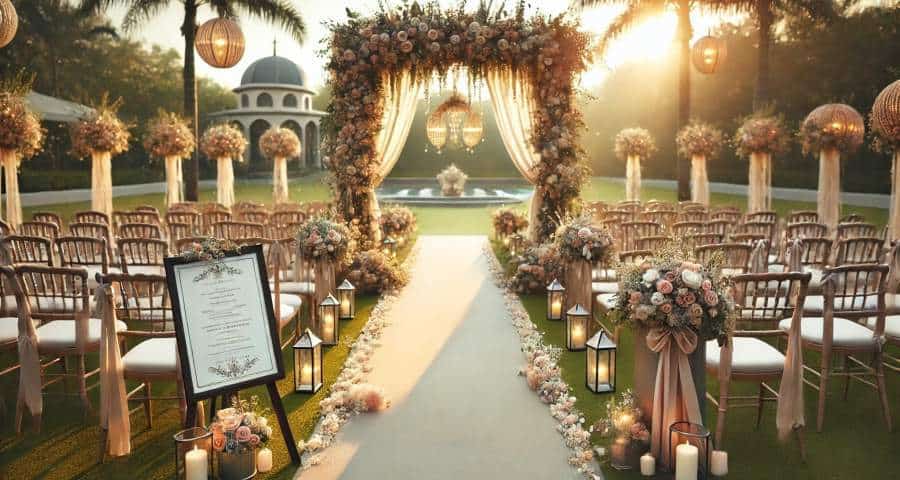
Creating a memorable and visually stunning wedding ceremony revolves around the thoughtful decoration of several key areas. From the moment guests arrive to the exchange of vows, each element should contribute to a harmonious and engaging atmosphere.
- Aisle Decorations: The walk down the aisle is a standout moment at any wedding. Enhancing this pathway not only sets the scene but also builds anticipation:
- Aisle Runners: Reflect your style with custom options like monogrammed fabrics or thematic patterns that add a personal touch.
- Chair Decorations: Adorn aisle chairs with ribbons, flowers, or small wreaths to integrate seamlessly with your overall decor.
- Floor Arrangements: Use lanterns, floral bouquets, or candles to line the aisle. For traditional elegance, sprinkle petals; for a magical evening effect, incorporate soft lighting.
- Altar or Ceremony Backdrop: This pivotal focal point is where your most cherished moments happen. Make it unforgettable:
- Floral Arches: Construct an arch using seasonal blooms that match your wedding theme. For a spring wedding, consider soft pastels; for fall, opt for rich reds and oranges. This not only creates a stunning visual but also ties the ceremony to the time of year.
- Fabric Draping: Artfully drape fabrics like tulle or chiffon, integrating fairy lights or delicate crystal accents to create a dreamy, romantic glow. For a DIY touch, source materials from local fabric stores and consult online tutorials to create your drapes.
- Custom Structures: Express your personality or cultural heritage with unique backdrops. For instance, repurpose vintage doors for a rustic wedding or use sleek, minimalistic panels for a modern aesthetic. These structures can often be rented or made with the help of skilled friends or local artisans.
- Entrance and Pathways: First impressions are crucial. Welcome your guests with a beautifully decorated entrance:
- Welcome Signs: Design signs that not only greet guests but also mirror your wedding aesthetics.
- Decorative Pathways: Lead guests to the ceremony area with decorations like petals or thematic lights that pave their path with charm.
- Guest Lounge Areas: Equip waiting areas with comfortable seating and thematic decor, offering a pleasant space for interaction and anticipation.
- Ceremony Programs and Signage: Details in printed materials are not just practical; they enhance your decor and guest experience:
- Ceremony Programs: Coordinate these with your overall theme, incorporating custom designs or motifs that appear throughout your wedding stationery.
- Signage: Use creatively designed signs for practical information, and sprinkle in personal touches like favourite quotes or lyrics that mean something special to you and your partner.
Floral Arrangements
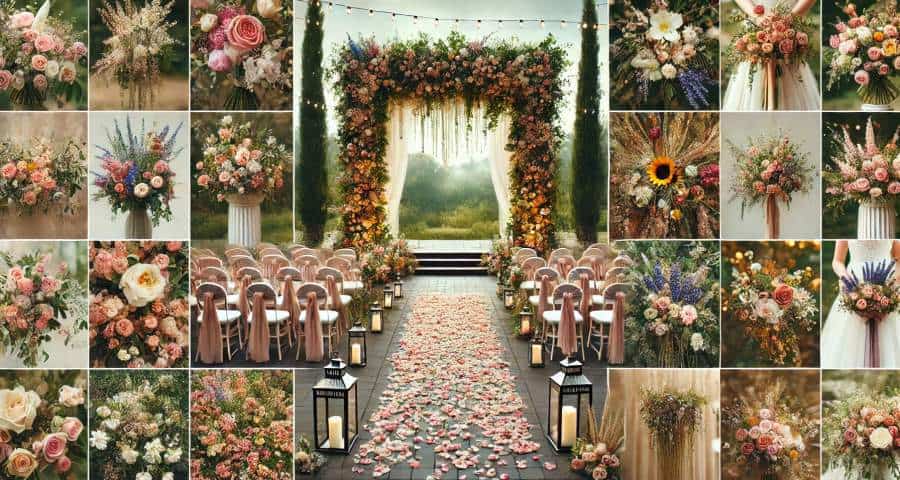
Floral arrangements are essential elements in setting the tone and enhancing the beauty of your wedding ceremony.
From the entrance to the altar, carefully chosen flowers can transform the space into a picturesque setting for your special moment.
- Aisle Decorations: Floral designs along the aisle add romance and beauty to your procession. Consider lining the aisle with:
- Petals: A carpet of rose petals for a classic, romantic touch.
- Lanterns with Flowers: Combining light and natural elements for an evening ceremony.
- Potted Plants: Great for an eco-friendly option that can be replanted after the wedding.
- Altar or Ceremony Backdrop: This crucial focal point is where you’ll exchange vows, so the floral decor here should be both striking and symbolic:
- Floral Arches: Create an archway adorned with flowers like roses for romance, ivy for fidelity, and peonies for prosperity, blending these with greenery for a lush look. This setup not only serves as a beautiful backdrop but also symbolises the new life you’re embarking on together.
- Large Arrangements: Position large, eye-catching arrangements on either side of the altar to frame the ceremony space. Consider using seasonal blooms that match your color scheme and adding elements like tall grasses or branches for more texture and depth.
- Considerations for Setup: Ensure these arrangements are secure, especially in outdoor settings where wind might be a factor. Discuss with your florist the best practices for anchoring large installations and consider backup plans for extreme weather conditions.
- Entrance and Pathways: The entrance sets the initial tone for your ceremony, making it essential to create an inviting and thematic first impression:
- Garlands: Use garlands draped along entryways to create a natural, flowing transition into the ceremony area. Opt for greenery mixed with lights for evening weddings or bright, colourful flowers for daytime celebrations.
- Floral Columns: Erect columns at the entrance adorned with flowers that tie into the ceremony’s overall colour scheme and theme. These can be made with reusable materials and designed to withstand various weather conditions, ensuring they remain stunning throughout the event.
- Seasonal Considerations for Flowers: Selecting flowers that are in season not only ensures the best quality and aesthetics but also helps manage costs effectively:
- Spring: Ideal for using tulips, hyacinths, and daffodils, which are naturally in bloom.
- Summer: Sunflowers, dahlias, and lavender provide vibrant colours and are heat-resistant.
- Fall: Incorporate rich-coloured blooms like marigolds, chrysanthemums, and dahlias to reflect the season’s palette.
- Winter: Opt for roses, amaryllis, and camellias, which thrive during the cooler months.
- Non-Floral Alternatives: For those with different preferences or budget considerations, non-floral elements can offer a unique and often more sustainable option:
- Greenery Only: Using various types of foliage to create lush, green backdrops or garlands.
- Dried Flowers and Grasses: These can add a rustic or bohemian vibe and are great for all seasons.
- Fabric and Ribbons: Creative use of fabrics and ribbons can add colour and texture without the cost of fresh blooms.
Lighting

Lighting is a powerful element in any wedding ceremony, capable of transforming a simple space into something truly magical.
- Setting the Mood with Lighting: The lighting you choose for your wedding ceremony plays a crucial role in establishing the overall mood.
- Romantic: To create a soft and romantic atmosphere, use warm, diffused lighting. Candles and string lights provide a gentle glow that can make an evening ceremony feel intimate and heartfelt.
- Whimsical: For a lighter, more whimsical feel, consider using fairy lights and lanterns. These can be hung from trees, placed along the aisle, or wrapped around columns to add a playful touch to your ceremony.
- Dramatic: To achieve a dramatic effect, focus on bold lighting contrasts and colours. Spotlights highlighting certain areas or architectural features, or uplighting at the base of structures can create striking visuals that add a sense of drama and sophistication.
- Innovative Lighting Techniques: Adding innovative lighting techniques can personalise your ceremony and make it truly unique:
- Projection and Gobos: Use projections or gobos to cast beautiful patterns, monograms, or images that are meaningful to you as a couple. This can transform a simple venue into a personalised space that reflects your story or wedding theme.
- LED Candles: In venues where open flames are not allowed, LED candles offer a safe alternative that still provides the soft, flickering light of real candles.
- Interactive Lighting: Consider incorporating interactive lighting elements that change with music or as guests move, adding an element of surprise and delight.
- Hiring Lighting Professionals: For couples planning especially elaborate or complex lighting setups, considering hiring a lighting professional or specialist is advisable. These experts can manage technical aspects, ensure safety standards are met, and help execute your vision flawlessly, removing the stress of DIY solutions for large scale or intricate designs.
- Lighting Options for Different Times of Day: The effectiveness of your lighting choices can depend significantly on the time of day and the specific restrictions of your venue.
- Daytime Ceremonies: Natural light plays a major role during the day. If your ceremony is outdoors, consider the sun’s position and how it affects the area. For indoor daytime ceremonies, enhance natural light with soft artificial lights that complement the daylight.
- Evening Ceremonies: This is when lighting can truly shine. Candles, fairy lights, and lanterns can transform an evening setting into a starlit paradise. Consider pathways lit by torches or lanterns for a beautiful and functional decoration that guides guests.
- Venue Restrictions: Always check with your venue about what types of lighting are permitted, especially concerning open flames. Many venues do not allow candles due to fire risks, but LED candles can be a beautiful and safe alternative.
- Practical Tips for Integrating Lighting:
- Coordinate with Your Florist and Decorator: Lighting can enhance floral and other decorations, so coordinating these elements is crucial. Discuss lighting placements that can best highlight the decor.
- Consider Power Sources: For outdoor or large venues, ensure there are adequate power sources for your lighting. This may require the use of battery-operated lights or the hiring of a professional to manage complex lighting setups.
- Test Your Lighting: Always test your lighting at the same time of day as your ceremony to see how it all looks under similar conditions. This can help you make necessary adjustments before the big day.
Applying your Theme or Style
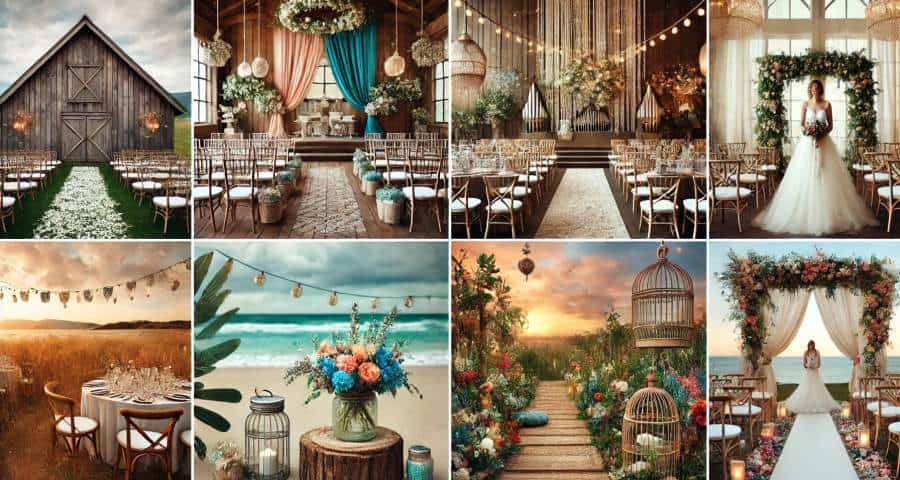
Applying your theme to your wedding ceremony venue is about more than decorating a space, it’s about creating an environment that reflects your personal style and celebrates your love story.
With careful planning and attention to detail, you can transform any venue into a personalised backdrop for one of the most memorable days of your life.
Remember, the key to a successful thematic wedding is not just in the big elements but in the subtle touches that resonate with personal significance.
- Understand Your Theme: Firstly, define your theme or style clearly. Whether it’s rustic charm, classic elegance, modern sophistication, or a whimsical fairy-tale, understanding the essence of your theme will guide every decision, from color schemes to decorative elements. If you’re still deciding on a theme, consider exploring popular wedding themes for inspiration and ideas.
- Theme Examples: Here are a few popular wedding themes to inspire your decoration choices:
- Rustic Charm: Use wooden elements, mason jars, and wildflowers. Incorporate burlap runners and lace accents for a countryside feel.
- Beach Paradise: Decorate with seashells, driftwood, and tropical flowers. Use shades of blue and sandy neutrals in your color scheme.
- Vintage Glamour: Opt for antique furniture pieces, lace details, and pearl accents. Use a color palette of soft pastels or rich jewel tones.
- Modern Chic: Embrace minimalistic designs with a sleek, contemporary look. Utilise geometric shapes, metallic finishes, and a monochromatic colour palette.
- Bohemian Whimsy: Feature eclectic, free-spirited decor with vibrant colours and patterns. Think macrame details, lush plants, and colourful textiles.
- Garden Elegance: Create a romantic outdoor setting with lots of greenery, floral garlands, and string lights. Use garden-inspired elements like birdcages and wooden benches.
- Design Your Ceremony Layout: Consider the structure of your ceremony space and how elements of your theme can enhance its natural beauty or features. Use your theme to guide the layout and flow of the space:
- Aisle: Decorate the walkway with elements that reflect your theme, such as lanterns, petals, or custom floor decals that lead to the altar.
- Altar: This focal point should be a standout feature that captures your theme vividly. Use backdrops, floral arches, or thematic structures to highlight this area.
- Seating: Arrange seating in a way that complements the venue and decorations, ensuring every guest feels part of the ceremony.
- Choose the Right Decorations: Select decorations that not only enhance the venue but also align closely with your theme:
- Florals: Choose flowers and arrangements that echo your theme’s style and colours. For instance, soft pastels and lush greenery for a garden theme, or vibrant tropical flowers for a beach setting.
- Lighting: Lighting can dramatically alter the ambiance. Soft, romantic lighting with candles and fairy lights works well for romantic or rustic themes, while bold, dramatic lighting suits modern or glamorous themes.
- Textiles: Drapery, table linens, and chair covers should complement your colour scheme and contribute to the theme’s overall feel.
- Focus on Cohesion: Ensure that every element from the entrance to the altar is harmoniously themed:
- Consistency: Keep your decorations consistent in style and colour throughout the venue to maintain a unified look.
- Transitions: Smooth transitions between different areas of your ceremony can enhance the guest experience, making the theme feel seamless and well-thought-out.
- Work With Professionals: For elaborate themes or decorations, consider hiring a professional decorator or wedding planner who specialises in themed weddings. They can provide valuable insights, source unique decorations, and ensure that your vision is executed flawlessly.
Remember, while a strong theme can create a memorable atmosphere, it’s important not to let it overshadow the true purpose of the day, celebrating your love and commitment. Aim for a balance that enhances the ceremony without distracting from its significance.
Adding a Personal Touch
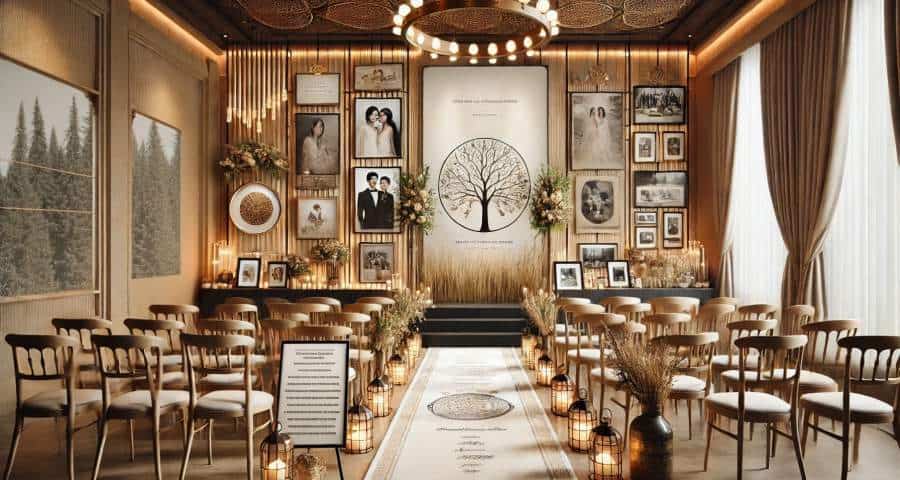
Every couple has a unique story, and your wedding ceremony is the perfect occasion to share that story with loved ones.
By incorporating personal elements into your ceremony decor, you can create a deeply meaningful and unforgettable experience that resonates emotionally with everyone present.
- Custom Art Pieces: For couples who are artists or enjoy crafting, incorporating artworks such as sculptures, paintings, or installations that you’ve created adds a deeply personal touch to the ceremony setting.
- Photo Displays: Create a gallery of family wedding photos from both sides of the family, set up near the entrance of your ceremony venue or in a dedicated area.
- Welcome Signs: Craft a beautifully designed welcome sign that reflects your wedding theme and personal style.
- Ceremony Backdrop: Consider a custom backdrop with a meaningful quote, lyric, or scripture that holds special significance for you as a couple.
- Custom Aisle Runner: Design an aisle runner featuring a timeline of major events in your relationship, leading up to the altar.
- Memorial Table: Designate a special area like a Memorial Table to honour deceased loved ones. Adorn the table with photos, memorabilia, or favourite items of the departed to make their presence felt during your special day.
- Heirloom Pieces: Include items such as your grandparents’ wedding rings, a vintage lace handkerchief, or a piece of jewellery passed down through generations.
- Cultural Symbols: Incorporate symbols significant to your culture as part of the decor, such as a Celtic hand-fasting ceremony or traditional Chinese lanterns.
- Religious Elements: If your ceremony is religious, include specific symbols like a cross or menorah, tastefully integrated into the decor.
- Storytelling Elements: Integrate small cards or booklets that tell the story of significant moments in your relationship.
- Interactive Guest Book: Create a guest book that reflects your interests, like puzzle pieces for guests to sign or a canvas for adding fingerprint leaves to a painted tree.
- Digital Storytelling: Use QR codes around the venue that guests can scan to view short videos or photo slideshows of your journey together.
- Signature Scent: Work with a perfumer to create a custom scent for your wedding day, used in candles or diffusers to create a unique sensory memory.
- Personalized Music: If musically inclined, consider composing a piece to be played during the ceremony, or create a playlist of songs that are meaningful in your relationship.
- Customised Favours: Offer guests personalised favours that reflect your journey or interests, such as custom blend tea bags or mini potted plants.
Examples of Personalized Ceremonies:
- A couple with a passion for travel used suitcases to decorate their venue, displaying photos from their trips and small souvenirs collected from around the world.
- Another couple, deeply rooted in their Greek heritage, incorporated olive branches and traditional Greek music into their ceremony decor.
DIY vs. Professional Decorators
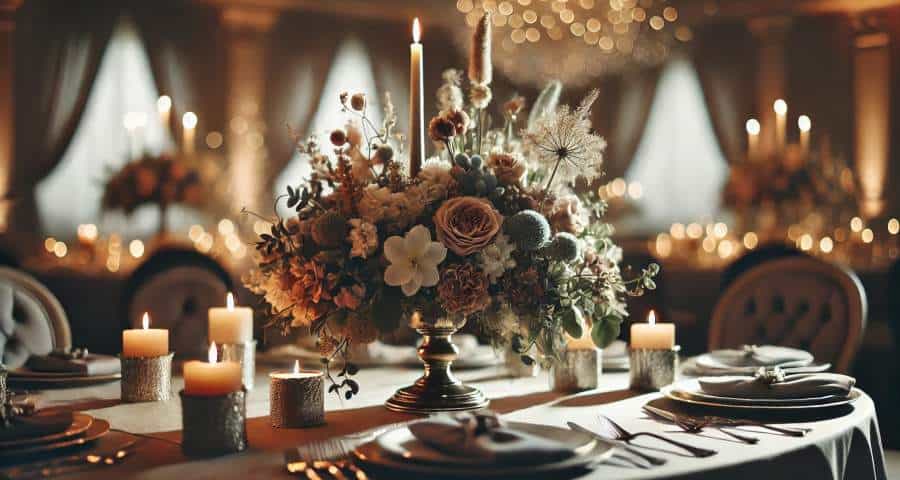
Decorating your wedding ceremony is a significant aspect of wedding planning. Choosing between a DIY approach and hiring a professional decorator is crucial and can greatly impact the aesthetics, atmosphere, and logistics of your big day. A hybrid approach or renting equipment for DIY projects can also provide flexible and cost-effective solutions.
Considerations for DIY Decorations
- Insurance and Liability: When planning DIY decorations, especially in rented venues, it’s important to consider the implications of insurance and liability. Accidents can happen—whether it’s a candle tipping over or a decoration falling—and it’s crucial to understand who is liable for such incidents. Ensure that your event insurance policy covers any potential damages caused by your decorations.
- Assessing Your Skills: Be realistic about your DIY abilities. Evaluate the complexity of the decorations you’re considering and your skill level. If a project seems too complex, it might be worth consulting a professional or choosing a simpler design. This assessment can help ensure that your vision is achievable without causing undue stress or requiring last-minute professional intervention.
Pros and Cons of DIY and Professional Decorations
- Personal Touch vs. Professional Expertise: DIY projects allow for a personal touch, but professionals offer expertise and resources that can elevate the aesthetics of your ceremony. Weigh these options based on your priorities, budget, and available time.
- Cost-Effectiveness vs. Time-Saving: While DIY can be more cost-effective, it often consumes more time. Professionals help save time but at a higher cost.
Hybrid Approach: Combining DIY and Professional Elements
- Balanced Involvement: Handle simpler tasks yourself and delegate complex or large-scale tasks to professionals. This approach allows you to be involved creatively without being overwhelmed.
Collaborating with Professional Decorators
Effective communication with your decorators is key to ensuring that your wedding decor matches your vision.
- Visual Inspiration and Specificity: Use detailed visuals and clear descriptions to share your ideas. This clarity helps decorators understand your style and execute it effectively.
- Feedback and Proposal Reviews: Engage in a feedback loop where you can review and approve proposals and mock-ups, ensuring they align with your overall vision.
- Regular Updates and Contract Transparency: Keep in touch with your decorators to monitor progress and make adjustments as needed. Ensure all agreements are clearly outlined in a contract.
By considering these additional factors, you can make a more informed decision about whether to pursue DIY decorations or hire professionals for your wedding. This thoughtful approach ensures that your wedding decor not only looks stunning but is also practical and secure.
Budgeting for Decorations
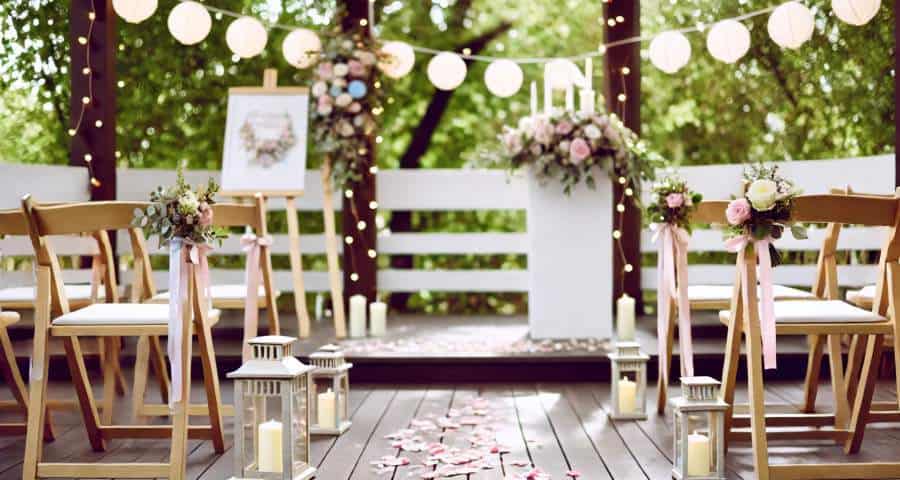
Decorating your wedding ceremony sets the tone for your special day, but managing the costs effectively can be challenging. By planning wisely, prioritising spending, and considering options like renting or repurposing decorations, you can create a beautiful setting without breaking the bank.
- Set a Clear Budget:
- Define Your Total Budget: Start by establishing how much you can spend on decorations within your overall wedding expenses.
- Include a Contingency Fund: Allocate 5-10% of your budget for unexpected costs, such as weather-related changes or last-minute decorative additions.
- Consider Timing:
- Seasonal Demand: The cost of decorations can vary significantly depending on the season. Opting for a wedding in the off-season can lead to lower prices on venues and decor.
- Last-Minute Opportunities: Sometimes, booking services closer to the date can result in discounts as vendors fill their schedules. However, this approach can be riskier and requires flexibility.
- Prioritise Key Elements:
- Determine Importance: Focus your budget on the elements most crucial to the wedding’s look and feel, like the altar or floral arrangements.
- Allocate Funds Accordingly: Ensure these prioritised elements receive the majority of your decoration budget.
- Invest in High-Impact Decorations:
- Visual Impact: Choose decorations that create significant visual impact, like dramatic backdrops or large floral installations.
- Guest Experience: Invest in elements that enhance the overall guest experience, such as ambient lighting and comfortable seating.
- Cost-Saving Strategies:
- Rent or Repurpose: Consider renting larger items and repurposing ceremony decorations at the reception.
- DIY Projects: Engage in DIY projects for more straightforward, less critical elements to save costs and add personal touches.
- Shop Smart: Utilise seasonal sales, bulk purchases, and price comparisons to get the best deals.
- Communicate with Vendors:
- Be Transparent: Discuss your budget limitations openly with decorators to explore cost-effective alternatives.
- Seek Creative Solutions: Allow professionals to suggest innovative ways to achieve the desired look within your budget.
Understanding how timing affects decoration costs can help you make more informed decisions, potentially saving money while still achieving your dream wedding aesthetic.

